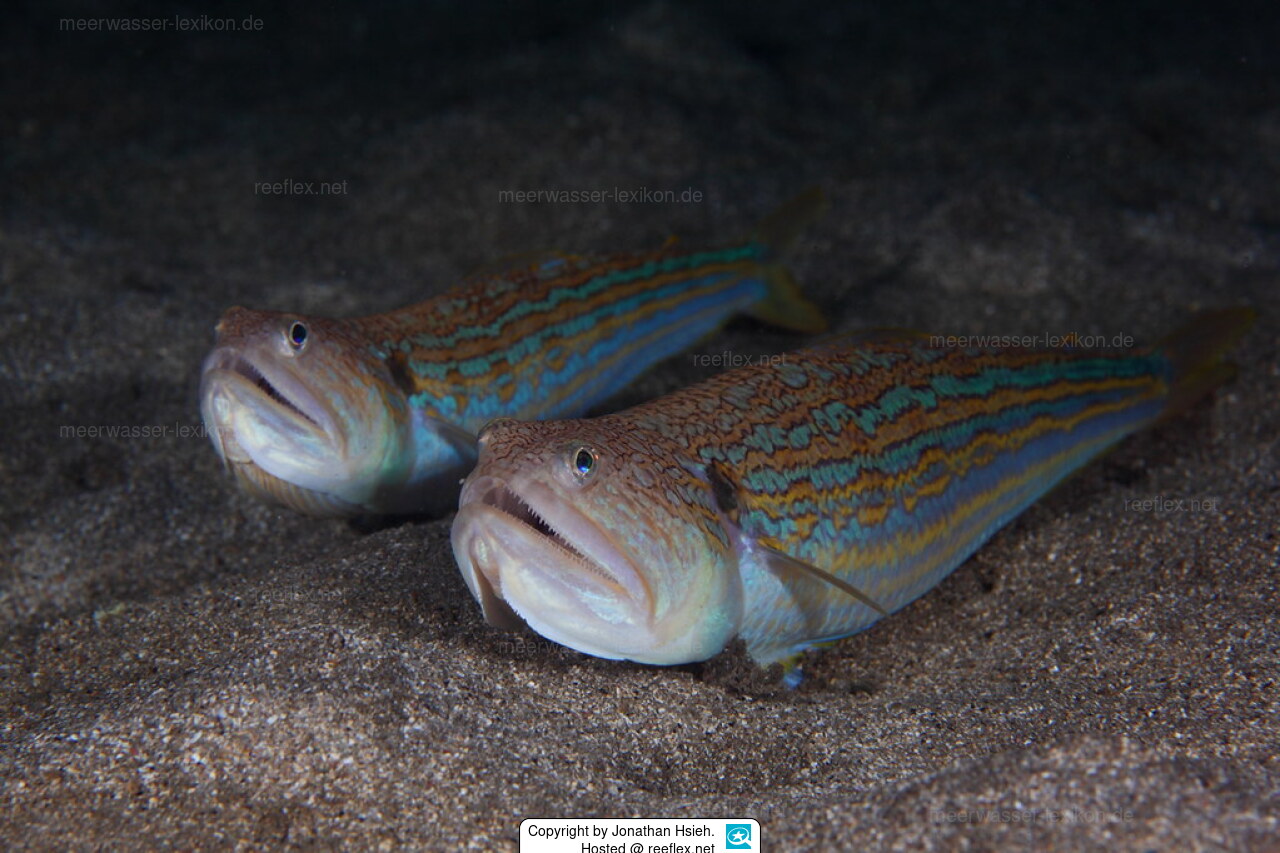Info
Trachinocephalus myops (Forster, 1801)
Trachinocephalus myops commonly known as snakefish or painted grinner can be found to a depth of about 100 m,over sandy bottoms, often burrow into substrate, leaving eyes exposed. This snakefish feeds on fishes and small crustaceans.
Trachinocephalus myops is the sole member of its genus.
Trachinocephalus myops is the only species of its genus and is commonly known as the lizardfish. Light blue and yellow wavy stripes with a few dark crossbars run along the sides of the body. It owes its name of painted lizardfish to this beautiful pattern. A dark spot is clearly visible at the gill opening.
The lizardfish can be found on sandy areas. It feeds on fish and small crustaceans. Trachinocephalus myops burrows into the sandy ground so that often only its eyes are visible.
The lizardfish can reach an age of 7 years.
Synonymised names:
Osmerus lemniscatus Lacepède, 1803 · unaccepted
Salmo myops Forster, 1801 · unaccepted
Saurus brevirostris Poey, 1860 · unaccepted
Saurus lemniscatus (Lacepède, 1803) · unaccepted
Saurus limbatus Eydoux & Souleyet, 1850 · unaccepted
Saurus myops (Forster, 1801) · unaccepted
Saurus truncatus Spix & Agassiz, 1829 · unaccepted
Synodus brevirostris (Poey, 1860) · unaccepted
Synodus myops (Forster, 1801) · unaccepted
Trachicephalus myops (Forster, 1801) · unaccepted (misspelling)
Trachinocephalus brevirostris (Poey, 1860) · unaccepted
Trachinocephalus limbatus (Eydoux & Souleyet, 1850) · unaccepted
Trachynocephalus myops (Forster, 1801) · unaccepted > misspelling
Trichinocephalus myops (Forster, 1801) · unaccepted (misspelling)
Trachinocephalus myops commonly known as snakefish or painted grinner can be found to a depth of about 100 m,over sandy bottoms, often burrow into substrate, leaving eyes exposed. This snakefish feeds on fishes and small crustaceans.
Trachinocephalus myops is the sole member of its genus.
Trachinocephalus myops is the only species of its genus and is commonly known as the lizardfish. Light blue and yellow wavy stripes with a few dark crossbars run along the sides of the body. It owes its name of painted lizardfish to this beautiful pattern. A dark spot is clearly visible at the gill opening.
The lizardfish can be found on sandy areas. It feeds on fish and small crustaceans. Trachinocephalus myops burrows into the sandy ground so that often only its eyes are visible.
The lizardfish can reach an age of 7 years.
Synonymised names:
Osmerus lemniscatus Lacepède, 1803 · unaccepted
Salmo myops Forster, 1801 · unaccepted
Saurus brevirostris Poey, 1860 · unaccepted
Saurus lemniscatus (Lacepède, 1803) · unaccepted
Saurus limbatus Eydoux & Souleyet, 1850 · unaccepted
Saurus myops (Forster, 1801) · unaccepted
Saurus truncatus Spix & Agassiz, 1829 · unaccepted
Synodus brevirostris (Poey, 1860) · unaccepted
Synodus myops (Forster, 1801) · unaccepted
Trachicephalus myops (Forster, 1801) · unaccepted (misspelling)
Trachinocephalus brevirostris (Poey, 1860) · unaccepted
Trachinocephalus limbatus (Eydoux & Souleyet, 1850) · unaccepted
Trachynocephalus myops (Forster, 1801) · unaccepted > misspelling
Trichinocephalus myops (Forster, 1801) · unaccepted (misspelling)







 Jonathan Hsieh
Jonathan Hsieh






